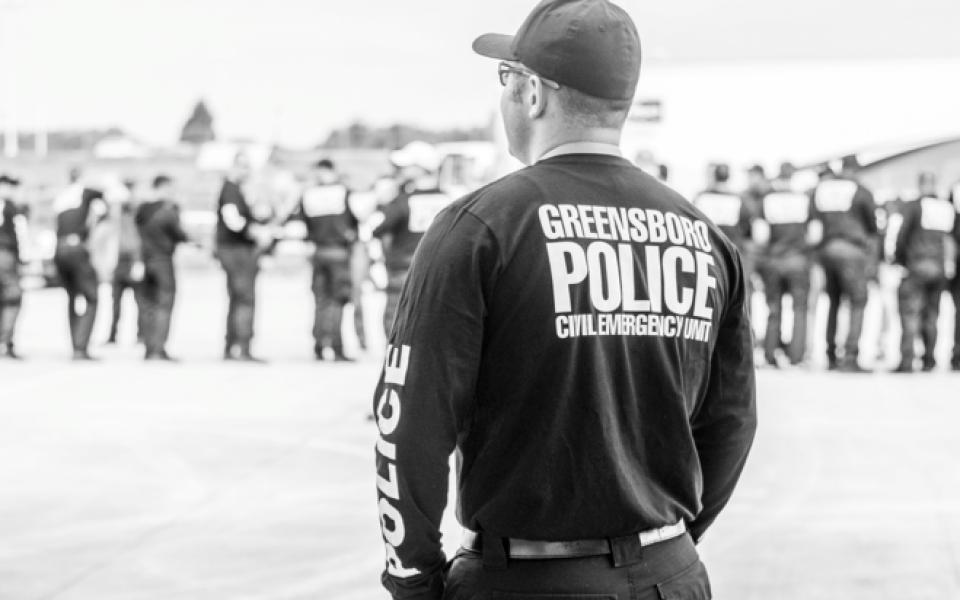After more than a month of waiting, the city of Greensboro released details of the Greensboro Police Department’s deployment to Charlotte following the police shooting of Keith Lamont Scott.
Responding to a public-information request filed by Triad City Beat on Sept. 24, the city provided information today outlining the police department’s involvement at the protests.
All but two of the officers sent to Charlotte for the protests following Scott’s death were part of the department’s Civil Emergency Unit, a secretive squad uncovered by TCB almost a year ago that is designed to respond to a variety of scenarios, including protests or riots. The other two officers were internal affairs sergeants, and “all of the Civil Emergency Unit officers have had training in crowd control,” according to the information provided by Special Operations Division Capt. JR Franks.
According to separate emails obtained by TCB, the Civil Emergency Unit participated in a training last year with the National Guard involving a mock protest and 45 fake protesters. The training also allowed the Hazardous Device team to work through “a scenario involving an unknown package being thrown over the fence near a pipeline valve by one of the protesters,” according to an internal email.
Greensboro police deployed to Charlotte for two days — Sept. 24 and 25 — with 57 different officers participating total, 43 of them on the first day and 51 on the second. Officers were assigned to either the bike or mobile field units, working about 16 hours each day.
The department brought two patrol cars, two Tahoes, one bus and one equipment transport truck each day, as well as a pickup towing an ATV trailer with two ATVs on the second day. Based on a departmental vehicle list from October 2015 provided to TCB, it appears the equipment transport truck is a white Ford E-550 van/box truck assigned to the Civil Emergency Unit.
All officers brought riot helmets, gas masks, ASP (presumably shorthand for a kind of police baton, though it is not immediately clear) and their duty weapons. Greensboro police also brought two medic bags, two first-aid kits and 60 riot shields, the latter of which didn’t end up being used, Franks wrote.
A June 2015 “extrication tool list” for the Civil Emergency Unit — also obtained separately by TCB — describes items that could be purchased for the unit including two sledge hammers, various saws, a shovel, safety goggles, a $1,150 generator and fire extinguishers, among other tools. It is not immediately clear what if any of the items on the list were purchased for the unit. The department also owns a long-range acoustic device, or LRAD, that the Civil Emergency Unit can use for crowd control. It doesn’t appear that police brought the LRAD to Charlotte.
The operation cost a total of $57,973, almost all of it in overtime pay ($53,820).
“The expenses were paid out of the Greensboro Police Department budget,” Franks wrote in the report. “We have submitted a reimbursement request to the NC Emergency Management.”
This list may seem unnecessarily detailed, and maybe it is. But given that countless residents have criticized the police department and the city for a lack of transparency around policing, TCB has attempted to provide as detailed an account of the department’s role in policing the Charlotte protests as possible. You can read more about the Civil Emergency Unit here, the Dejuan Yourse case here and Greensboro police use of force here.
Join the First Amendment Society, a membership that goes directly to funding TCB‘s newsroom.
We believe that reporting can save the world.
The TCB First Amendment Society recognizes the vital role of a free, unfettered press with a bundling of local experiences designed to build community, and unique engagements with our newsroom that will help you understand, and shape, local journalism’s critical role in uplifting the people in our cities.
All revenue goes directly into the newsroom as reporters’ salaries and freelance commissions.


Leave a Reply